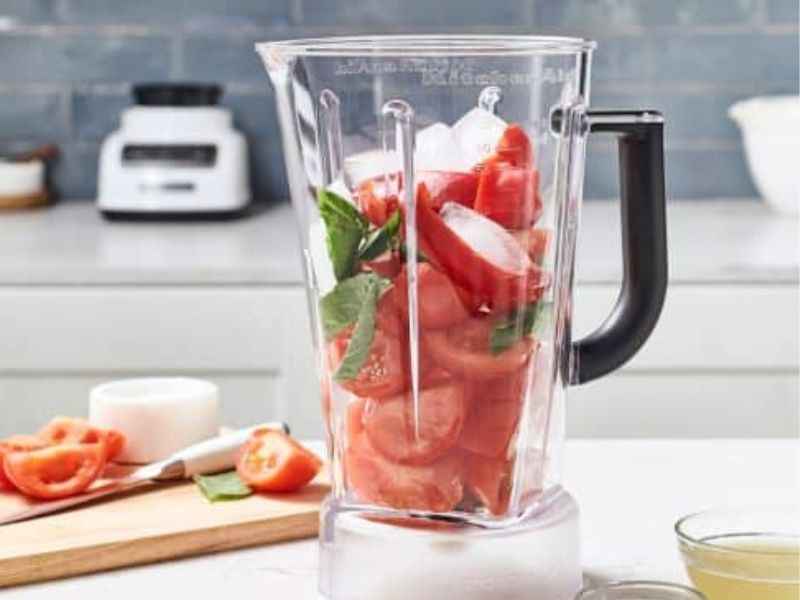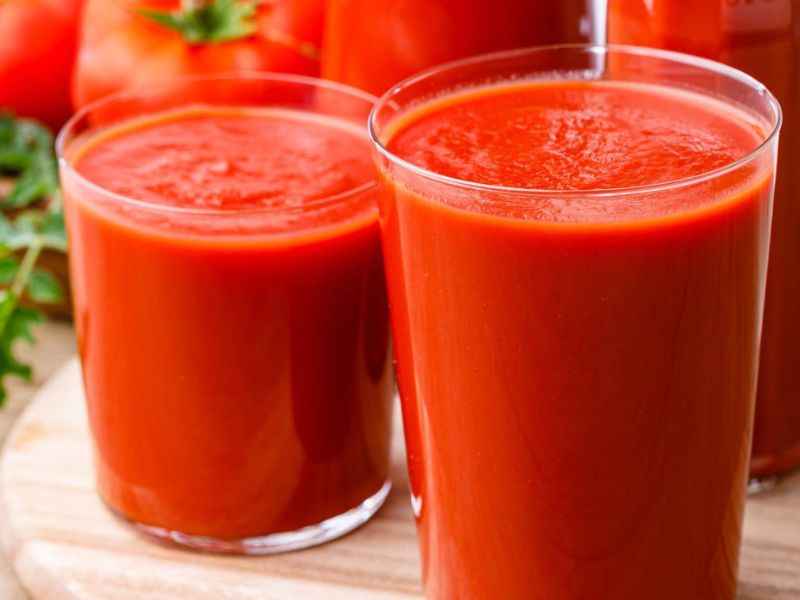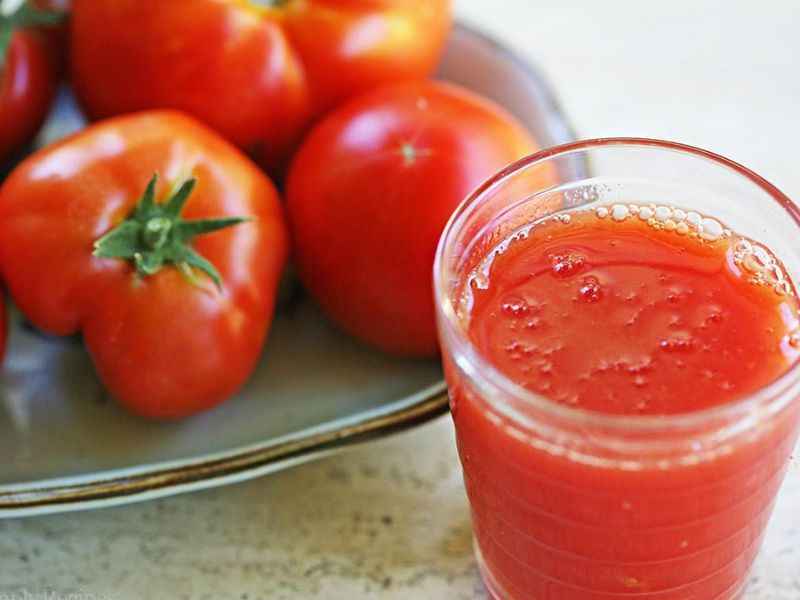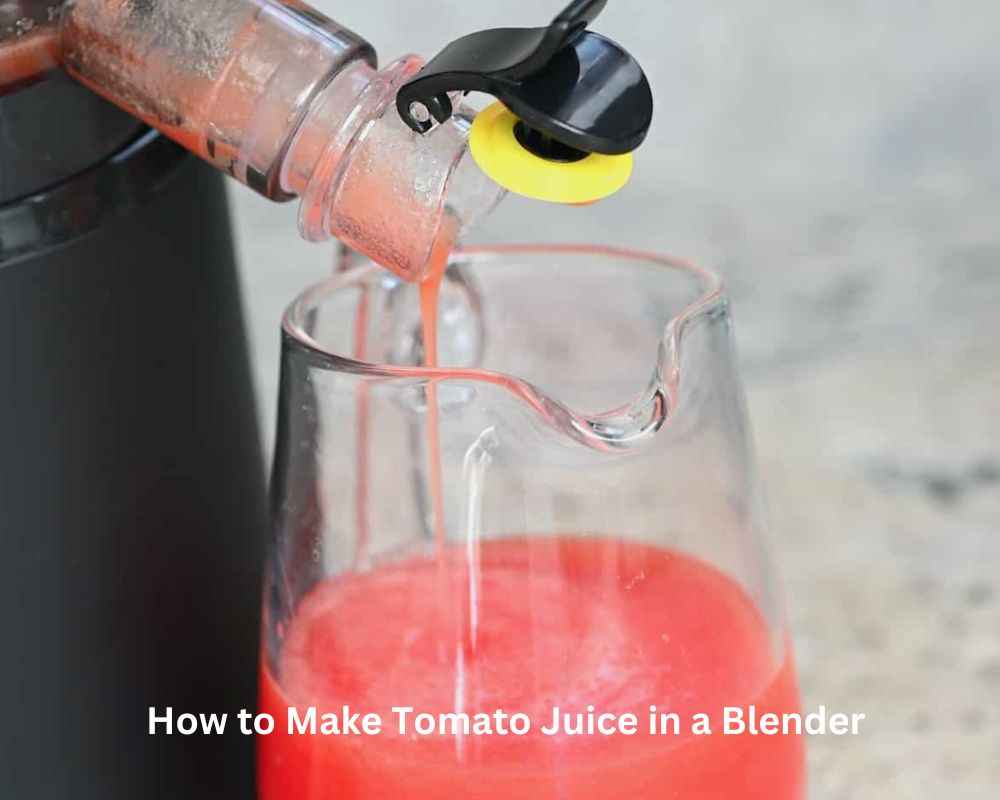Tomato juices are usually prepared in the juicer. But a blender is also a good option for making this drink. Also, preparing tomato juice is super easy with a blender. Wondering about the taste? As long as you know the right procedure of how to make tomato juice in a blender, the taste will be as good as the real thing.
The shared recipe is suitable for homemade tomato juice which are easy to follow. Moreover, the drink will be a lot better than something you buy in a bottle!
What is the Process of Making Tomato Juice in a Blender?

Creating fresh tomato juice from home is a breeze. To help you make tomato juice in a blender, we’ve laid down some simple processes.
Step 01: Gather the Ingredients
- Pick fresh tomatoes, then rinse, dry, and slice them. The number of tomatoes you use relies on your preferences. Take the tomatoes and discard the seeds. To get an even more intense taste, you may also mix other veggies and fruits, including celery, carrots, apples, and so forth. Reduce the size of each component by chopping or cutting it.
- It is imperative that you keep sufficient sugar and salt at the go.
- Home appliances required in the kitchen: Blender and strainer (or sieve).
Step 02: Blend
- To begin, choose a good quality spacious blender. Place each of the components into their respective slots in the jug. It will be much simpler to grind if you only add a touch of water to it first. It is important not to overload the container since doing so might lead to blockage and an inconsistent mixing.
- Get the blender up and running. You have some leeway in selecting the appropriate functionality, based on the goods you purchase. Certain new blenders offer a pre-set juicing setting for the optimal adjustments.
- The next factor that determines how smooth and consistent the tomato juice will be is the quantity of filtered water used. If we use an excessive amount of water in relation to the quantity of tomatoes that we use, it will be simple to dilute the drink, and the juice will not have a high nutritious value. As a result, you shouldn’t give more than the appropriate amount.
Step 03: Extract
All the pureed tomatoes will be strained through a fine mesh sieve to separate the juice from the pulp and skins. You may adjust the sweetness to your taste.
Step 04: Enjoy!
Tomato juice is best served chilled, so fill a glass with ice and pour some in.
Appropriate Amount of Tomato Juice for Health
You should limit yourself to around a cup of pure, unstrained tomato juice every day. Tomato juice has been linked to digestive issues and acid reflux if consumed in large amounts. On top of that, if you’re tired of drinking the same old tomato juice every day, try including a wider variety of fruits and greens into your diet.
Make just what you need for each individual serving. Be cautious if refrigerated before consuming. When juice loses its freshness and nutritional value due to oxidation, it may produce off flavors, foam, and/or a different color, all of which may aggravate stomach discomfort.
What is the Tomato Juice’s Health Privileges?

Tomato is a common vegetable, but have you really investigated its potential health benefits?
Vitamins A and C, found in abundance in this plant, are known to be beneficial to eye health. In addition, they are rich in the minerals potassium, folate, magnesium, niacin, thiamin, and phosphorus, all of which contribute to a healthier body and glowing skin.
Tomato juice, in specific, is useful in preventing stomach and lung cancer due to its high lycopene concentration. And with the straightforward procedures we’ll outline here, you’ll soon be enjoying a refreshing glass of homemade tomato juice.
Additionally, it aids rapid weight loss due to its high fiber and vitamin content and low fat & cholesterol levels. Tomatoes help maintain robust bonds thanks to the vitamin K and calcium they contain. Tomatoes have several beneficial effects on our health, making them an essential part of human diet.
Why Making Tomato Juice at Home is Beneficial?
Tomato juice, like raw tomatoes, is loaded with health advantages. Tomato juice includes almost 20% of the necessary value for vitamin A and practically all of the vitamin C necessary for the day in only one cup (240ml).
Furthermore, the carotenoids in tomato juice function as a powerful antioxidant, guarding from oxidative stress, lowering inflammation, and shielding against some malignancies; this juice may boost the health of your eyes and heart.
Some research suggests it may also reduce the risk of blood clots, and its vitamin and mineral content benefits bones and healthy skin while also aiding the body’s detoxification processes by stimulating the liver and kidneys.
It’s recommended to make your own tomato juice since it’s the healthiest and tastiest option. If you take the time to pick out the best tomatoes and discard those that are damaged, you can make a drink that doesn’t stink. And with only a little blender and a couple of easy actions, you can enjoy a glass of fresh tomato juice.
Tomato juice in cans is also popular. Some items, on the other hand, have salt and artificial flavors added to them to make them stay longer and taste better. Excessive consumption of such products has been associated to a number of health concerns.
Sugar content may be modified to suit individual preferences. You may adjust the taste anyway you desire by combining different ingredients.
What are the Uses of Tomato Juice?

Besides sipping it straight or mixing it with other juices, you can put your fresh tomato juice to good use in a variety of different ways.
- Use this tomato juice for your own Bloody Mary (virgin or not!) and experience the traditional option.
- To give your bloody Mary a fizzy twist, try mixing in some carbonated water or lemonade.
- If you have a juicer, you can make spicy tomato juice by juicing a jalapeño or other hot pepper, depending on your tolerance for heat. Mixing in little cayenne or red pepper may give the juice a little spice as well. A few of our favorite additions to spicy tomato juice are celery and bell pepper.
- You may have this tomato juice combined with a variety of different fruits and vegetables, such as citrus, carrots, pears, watermelon, beets, cucumbers, ginger, etc. Throw in some sugar or honey to taste.
- Soup base is an alternative to or addition to stock. Gazpacho benefits from its inclusion, as well.
- Unused tomato juice may be utilized instead of or in addition to canned tomatoes for a different flavor in chili.
- Tomato juice is great for flavoring rice and other grains, such as Mexican rice, when it has been left over from another meal. The same holds true with spaghetti.
- Add some tomato juice (or the ice) to your favorite smoothie or shake and mix until smooth.
- Some tomato juice may be added to homemade vegetable stock to enhance the taste.
What are the Symptoms the Tomato Juice Is Going Sour?
Here are three telltale signs that your tomato juice is going bad, in case you don’t know what to look for:
- The tomato juice should be thrown away if you smell anything bitter when you open the bottle. The alcoholic or vinegar-like smell that develops in aged tomato juice may be the result of fermentation.
- Tomato juice’s color and consistency will change from red to brown as it oxidizes, a sign that it’s no longer in good health.
- Last but not least, if you see mold in the tomato juice, even if it’s only a fuzzy film of white or green on top, toss it away immediately.
FAQs –How to Make Tomato Juice in a Blender
My handmade tomato juice seems to be runny and straining; what may be causing this?
The juice is best consumed after being chilled, although it may be enjoyed raw if shaken well before consumption.
What spices or herbs go well with tomato juice?
How to Preserve of Tomato Juice?
To preserve its high nutritional value and peak freshness, tomato juice is best consumed the same day it is made. After that, you may leave it out for 4 hours at ambient temperature or store it in the fridge for even longer.
Nonetheless, you shouldn’t leave it alone all night. Its longevity can be prolonged by freezing it for up to a week.
Conclusion
Tomatoes are very beneficial food because of their high nutrient content. At home, you may learn how to make tomato juice in a blender by reading my above step by step guide.
Raw tomatoes are available year-round, whether you produce them in your own yard or purchase them from the marketplace. Making your own juice at home is effortless, and you can customize your nutritious drink to your liking by adding your favorite ingredients and spices.
Related Posts
- Process to make smoothies in a blender
- Guide to make ice cream in a blender
- How to crush ice with a blender in effective ways
